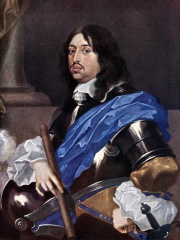
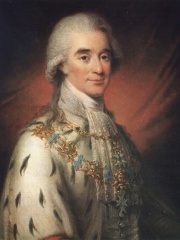
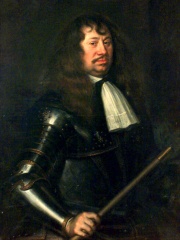
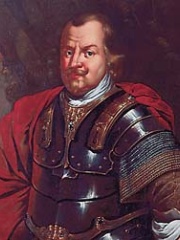
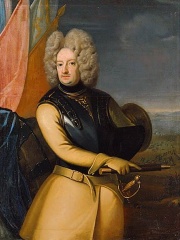
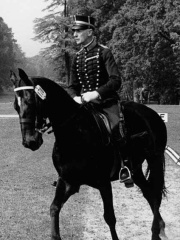

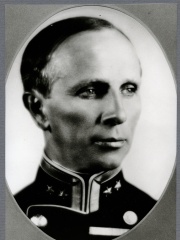
The Most Famous
MILITARY PERSONNELS from Sweden
This page contains a list of the greatest Swedish Military Personnels. The pantheon dataset contains 2,058 Military Personnels, 9 of which were born in Sweden. This makes Sweden the birth place of the 29th most number of Military Personnels behind Ireland, and Azerbaijan.
Top 9
The following people are considered by Pantheon to be the most legendary Swedish Military Personnels of all time. This list of famous Swedish Military Personnels is sorted by HPI (Historical Popularity Index), a metric that aggregates information on a biography's online popularity.

1. Charles X Gustav of Sweden (1622 - 1660)
With an HPI of 78.35, Charles X Gustav of Sweden is the most famous Swedish Military Personnel. His biography has been translated into 56 different languages on wikipedia.
Charles X Gustav, also Carl X Gustav (Swedish: Karl X Gustav; 8 November 1622 – 13 February 1660), was King of Sweden from 1654 until his death in 1660. He was the son of John Casimir, Count Palatine (Pfalzgraf) of Zweibrücken-Kleeburg, and Catherine of Sweden. After his father's death, he also succeeded him as Pfalzgraf. He was married to Hedwig Eleonora of Holstein-Gottorp, who bore his son and successor, Charles XI. Charles X Gustav was the second Wittelsbach king of Sweden after the childless king Christopher of Bavaria (1441–1448) and he was the first king of the Swedish Caroline era, which had its peak during the end of the reign of his son, Charles XI. He led Sweden during the Second Northern War, enlarging the Swedish Empire. By his predecessor Christina, he was considered de facto Duke of Eyland (Öland), before ascending to the Swedish throne. From 1655 to 1657, he also claimed the title of Grand Duke of Lithuania. His numbering as Charles X derives from a 16th-century invention. One of his predecessors, Charles IX (1604–1611), chose his numeral after studying a fictitious history of Sweden. Charles X Gustav was the fourth actual King Charles, but has never been called Charles IV.

2. Axel von Fersen the Younger (1755 - 1810)
With an HPI of 74.09, Axel von Fersen the Younger is the 2nd most famous Swedish Military Personnel. His biography has been translated into 24 different languages.
Hans Axel von Fersen (Swedish: [hɑːns ˈǎksɛl fɔn ˈfæ̌ʂːɛn]; 4 September 1755 – 20 June 1810), also known as Axel von Fersen the Younger and as Axel de Fersen in France, was a Swedish count, military officer, courtier, ambassador, Marshal and Lord of the Realm. He gained international renown for his close association with Queen Marie Antoinette of France and his prominent involvement in the French Revolution. Born into one of Sweden’s wealthiest and most influential noble families, von Fersen was raised in an environment shaped by French culture and courtly traditions. He received a thorough military education, travelled extensively throughout Europe, and served as an aide-de-camp in the French Army during the American Revolutionary War. He is most widely remembered for his close and often debated relationship with Marie Antoinette, which some historians believe developed into a romantic affair. Von Fersen became a trusted confidant of the French royal family and played a pivotal role in organizing and executing their ill-fated flight to Varennes in June 1791. Following the outbreak of the French Revolution and the execution of the royal family, von Fersen continued to act as a diplomat on behalf of Kings Gustav III and Gustav IV Adolf of Sweden, working to preserve ties with the French monarchy and support its restoration. Returning to Sweden in the 1790s, he held several high-ranking positions, including Marshal of the Realm and Chancellor of Uppsala University. His life came to a violent end in June 1810, when he was killed by a lynch mob in Stockholm amid false rumors implicating him in the sudden death of Charles August, Crown Prince of Sweden. Subsequent investigations cleared him of all suspicion, and he was buried with honor. Von Fersen’s life—particularly his ties to Marie Antoinette—has been widely portrayed in historical and fictional works, including films, television series, and stage productions.

3. Carl Gustaf Wrangel (1613 - 1676)
With an HPI of 65.51, Carl Gustaf Wrangel is the 3rd most famous Swedish Military Personnel. His biography has been translated into 27 different languages.
Fältmarskalk Carl Gustaf Wrangel (also Carl Gustav von Wrangel; 23 December 1613 – 5 July 1676) was a Swedish statesman and military commander who commanded the Swedish forces in the Thirty Years' War, as well as the Torstenson, Bremen, Second Northern and Scanian Wars. A Baltic German, he held the ranks of a Field Marshal, Commander-in-Chief of the Swedish forces in Germany (1646–1648), and Lord High Admiral of Sweden (from 1657). Wrangel was Governor-General of Swedish Pomerania (1648–1652 and 1656–1676) and, from 1664, Lord High Constable of Sweden and a member of the Privy Council. He held the title of a Count of Salmis until 1665, when he became Count of Sölvesborg. By 1673, Wrangel's title was "Count of Sölvesborg, Freiherr of Lindeberg and Ludenhof, Lord of Skokloster, Bremervörde, Wrangelsburg, Spyker, Rappin, Ekebyhov, Gripenberg and Rostorp". From 1658, Wrangel was Supreme judge in Uppland, and in 1660, he became Chancellor of the University of Greifswald. He held several estates, primarily in the Dominions of Sweden, where he constructed representative mansions: Wrangelsburg, in Pomerania, still bears his name. Wrangel is part of the Wrangel family and was a close friend of King Charles X Gustav of Sweden.

4. Johan Banér (1596 - 1641)
With an HPI of 65.22, Johan Banér is the 4th most famous Swedish Military Personnel. His biography has been translated into 24 different languages.
Johan Banér (23 June 1596 – 10 May 1641) was a Swedish field marshal in the Thirty Years' War.
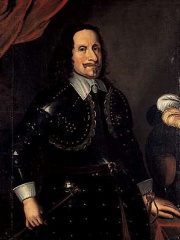
5. Gustav Horn, Count of Pori (1592 - 1657)
With an HPI of 63.82, Gustav Horn, Count of Pori is the 5th most famous Swedish Military Personnel. His biography has been translated into 21 different languages.
Count Gustav Horn (October 22, 1592 – May 10, 1657) was a Swedish nobleman, military officer, and Governor-General. He was appointed member of the Royal Council in 1625, Field Marshal in 1628, Governor General of Livonia in 1652 and Lord High Constable since 1653. In the Thirty Years' War (1618–1648), he was instrumental as a commander in securing victory at the Battle of Breitenfeld, in 1631. He was High Councillor of the realm in 1625, elevated to the rank of field marshal in 1628, and sometimes commander-in-chief of Swedish forces in Germany during Thirty Years' War. After the war, he served as Governor-General of Livonia 1652, President of War department and Lord High Constable in 1653. In 1651, Queen Christina created him Count of Björneborg (Horn af Björneborg).

6. Magnus Stenbock (1664 - 1717)
With an HPI of 62.44, Magnus Stenbock is the 6th most famous Swedish Military Personnel. His biography has been translated into 20 different languages.
Count Magnus Stenbock (22 May 1665 – 23 February 1717) was a Swedish field marshal (Fältmarskalk) and Royal Councillor. A commander of the Carolean Army during the Great Northern War, he was a prominent member of the Stenbock family. He studied at Uppsala University and joined the Swedish Army during the Nine Years' War, participating in the Battle of Fleurus in 1690. After the battle, he was appointed lieutenant colonel, entered Holy Roman service as Adjutant General, and married Eva Magdalena Oxenstierna, daughter of statesman Bengt Gabrielsson Oxenstierna. Returning to Swedish service he received colonelcy of a regiment in Wismar, and later became colonel of the Kalmar and then Dalarna regiments. During the Great Northern War, Stenbock served under King Charles XII in his military campaigns in the Baltic and Polish fronts. As director of the General War Commissariat, Stenbock collected substantial funds and supplies for the maintenance of the Swedish army, earning the admiration of Charles XII. In 1705, he was appointed general of the infantry and Governor General of Scania. As acting governor, Stenbock displayed his administrative skills and organized Scania's defense against an invading Danish army, which he defeated at the Battle of Helsingborg in 1710. In 1712, he conducted a campaign in northern Germany and defeated a Saxon-Danish army at the Battle of Gadebusch, which earned him his field marshal's baton. His career plummeted after his merciless destruction of the city of Altona in 1713. Surrounded by overwhelming allied troops, Stenbock was forced to surrender to King Frederick IV of Denmark during the siege of Tönning. During his captivity in Copenhagen, the Danes revealed Stenbock's escape attempt and imprisoned him in Kastellet. There he was the subject to a defamation campaign conducted by Frederick IV and died in 1717 after years of harsh treatment. Besides his military and administrative professions, Stenbock was regarded as a skilled speaker, painter and craftsman. His military successes contributed to the creation of a heroic cult in Sweden. During the age of romantic nationalism he was consistently praised by Swedish historians and cultural personalities, such as Carl Snoilsky in his poem "Stenbock's courier". His name has inspired streets in several Swedish cities and in 1901 an equestrian statue of Stenbock was unveiled outside Helsingborg city hall.

7. Henri Saint Cyr (1902 - 1979)
With an HPI of 59.62, Henri Saint Cyr is the 7th most famous Swedish Military Personnel. His biography has been translated into 19 different languages.
Henri Julius Reverony Saint Cyr (15 March 1902 – 27 July 1979) was a Swedish officer and equestrian. Competing in five consecutive Olympics, he won two gold medals in dressage in 1952, and two gold medals in 1956.

8. Hans von Rosen (1888 - 1952)
With an HPI of 57.19, Hans von Rosen is the 8th most famous Swedish Military Personnel. His biography has been translated into 18 different languages.
Count Hans Robert von Rosen (8 August 1888 – 2 September 1952) was a Swedish Army captain and horse rider who competed in the 1912 Summer Olympics and in the 1920 Summer Olympics.

9. Gustaf Dyrssen (1891 - 1981)
With an HPI of 56.75, Gustaf Dyrssen is the 9th most famous Swedish Military Personnel. His biography has been translated into 22 different languages.
Lieutenant General Gustaf Peder Wilhelm Dyrssen (24 November 1891 – 13 May 1981) was a Swedish Army officer and Olympic modern pentathlete. Dyrssen had an extensive and distinguished military career, starting as a second lieutenant in the Svea Artillery Regiment in 1912. Over the years, he rose through the ranks, serving in various capacities, including as a captain in the General Staff and as the commander of the Svea Artillery Regiment. His career highlights include being appointed major in 1934, major general in 1944, and eventually serving as the military commander of the IV Military District and the Commandant General in Stockholm from 1945 to 1957. Dyrssen retired from the Army in 1957 but continued as lieutenant general in the reserve. Beyond his military achievements, Dyrssen was a successful athlete. He excelled in the modern pentathlon, winning a gold medal in 1920 and a silver medal in 1924 at the Summer Olympics. Additionally, he earned medals in épée at the world championships and national titles in various years. Dyrssen's sports involvement extended to administration, where he held prominent positions such as president of the Swedish Fencing Federation, president of the International Modern Pentathlon Union, and a member of the International Olympic Committee. In addition to his military and athletic pursuits, Dyrssen was actively involved in various committees and organizations, including chairing the Railway Preparedness Investigation and the Inter-Scandinavian Transit Committee. He also served on the Swedish Olympic Committee and held leadership roles in associations promoting sports and outdoor activities.
People
Pantheon has 9 people classified as Swedish military personnels born between 1592 and 1902. Of these 9, none of them are still alive today. The most famous deceased Swedish military personnels include Charles X Gustav of Sweden, Axel von Fersen the Younger, and Carl Gustaf Wrangel.
Deceased Swedish Military Personnels
Go to all RankingsCharles X Gustav of Sweden
1622 - 1660
HPI: 78.35
Axel von Fersen the Younger
1755 - 1810
HPI: 74.09
Carl Gustaf Wrangel
1613 - 1676
HPI: 65.51
Johan Banér
1596 - 1641
HPI: 65.22
Gustav Horn, Count of Pori
1592 - 1657
HPI: 63.82
Magnus Stenbock
1664 - 1717
HPI: 62.44
Henri Saint Cyr
1902 - 1979
HPI: 59.62
Hans von Rosen
1888 - 1952
HPI: 57.19
Gustaf Dyrssen
1891 - 1981
HPI: 56.75
Overlapping Lives
Which Military Personnels were alive at the same time? This visualization shows the lifespans of the 4 most globally memorable Military Personnels since 1700.

